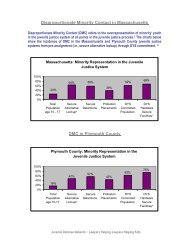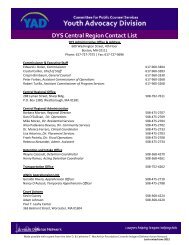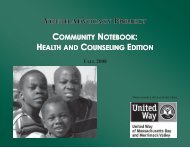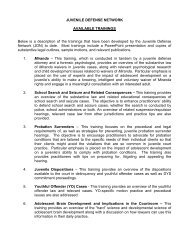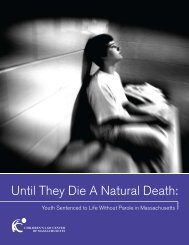States rethink 'adult time for adult crime' - the Youth Advocacy Division
States rethink 'adult time for adult crime' - the Youth Advocacy Division
States rethink 'adult time for adult crime' - the Youth Advocacy Division
Create successful ePaper yourself
Turn your PDF publications into a flip-book with our unique Google optimized e-Paper software.
Brain science offers insight to teen crime : Special Reports : Albuquerque Tribune<br />
activity is taking place - and where it isn't - that makes <strong>the</strong> crucial difference.<br />
The gray matter chatter in a teen brain is in full swing deep within <strong>the</strong> temporal lobe in an almond-shaped bulge<br />
called <strong>the</strong> amygdala, <strong>the</strong> brain's emotional center.<br />
In <strong>adult</strong>s, <strong>the</strong> amygdala's emotional and often impulsive or erratic reactions such as anger, fear and recklessness<br />
are tempered by <strong>the</strong> reasoning and social awareness of <strong>the</strong> brain's frontal lobe.<br />
Cerebral construction is not complete until around ages 20 to 25, most scientists agree. The frontal lobe is one of<br />
<strong>the</strong> last areas of <strong>the</strong> brain to develop.<br />
In <strong>the</strong> adolescent brain, it's barely firing at all.<br />
Without <strong>the</strong> frontal lobe on board, it becomes physiologically harder <strong>for</strong> a teen to completely understand <strong>the</strong><br />
future consequences of his or her emotional or impulsive actions, scientists contend.<br />
"Thus, <strong>the</strong>re is good reason to believe that adolescents, as compared with <strong>adult</strong>s, are more susceptible to<br />
influence, less future-oriented, less risk averse and less able to manage <strong>the</strong>ir impulses and behavior," Steinberg<br />
said.<br />
He and o<strong>the</strong>rs advocate that such a discrepancy in brain function should be taken into consideration when<br />
deciding to seek juvenile or <strong>adult</strong> sanctions.<br />
Childhood abuse and neglect fur<strong>the</strong>r hampers normal brain development, researchers say. A recent study by <strong>the</strong><br />
Juvenile Justice Center of <strong>the</strong> American Bar Association found that a majority of juveniles on death rows across<br />
<strong>the</strong> country had been abused or neglected as children.<br />
A U.S. Supreme Court decision last year now prohibits sentencing a juvenile to death, a decision that took into<br />
http://www.abqtrib.com/news/2006/dec/08/brain-science-offers-insight-teen-crime/ (3 of 6)12/15/2006 2:32:28 PM





